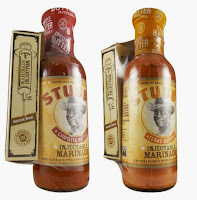*Brine for optimum juiciness. Plan on brining your turkey for at least two days for a fresh or thawed bird, and at least 3 days if starting with a frozen turkey. Be sure to use a lidded container that is large enough to completely submerge the turkey along with some sealed bags of ice (to keep the turkey at a safe temperature). Remember to replace any thawing ice packs with new frozen ones to keep the brine cold enough. If you've never made your own brine, try our basic brine recipe or The Hound's Brine (a classic old recipe), or my personal favorite, Greg's Secret Turkey Brine.
*Do This for Crispy Skin: Use paper towels to thoroughly pat the turkey dry after brining. Surface water is the enemy of crispy skin. Before placing the turkey in your smoker, use your fingers or a basting brush or mop to coat the skin with olive oil and then pat on a poultry rub such as Gobblin' Good Turkey Rub or Bone Suckin' Poultry Seasoning.
*Control the Smoker Temperature. Keep your smoker at around 300°F degrees, and smoke the turkey until its internal temperature reaches 180°F. When checking the temperature of the turkey, use a good meat thermometer to check in the breast and in the thighs (make sure the probe doesn't touch the bone, which can give you a false reading) to make sure the entire bird has reached 180°F. This can take around 5 hours for a 20-lb. bird, but your time will vary depending on the weather (cold, damp days mean longer smoking times) and the size of your bird. Do NOT stuff the turkey before smoking it -- that's a recipe for disaster, aka food poisoning! Instead, for the sake of safety cook the stuffing separately -- which I guess makes it dressing rather than stuffing.
*To Inject, or Not? Experts are divided on the use of injectable marinades for smoked turkey. Some people swear that the best way to ensure that the entire turkey is infused with richly seasoned juices is to inject it prior to smoking with a good quality butter or oil-based marinade. Injecting the breast can also protect against overcooking and drying out while the darker meat finishes cooking (this is especially useful if you're new to smoking, or if your smoker tends to run hot. If you decide to try injectable marinades, I recommend either flavor of Stubb's Injectable Marinades. They're all-natural, made with butter, and easy to use. Choose between sassy-sweet Texas Butter or smoky-spicy Chipotle Butter.
One final tidbit of advice: Don't be surprised if your smoked turkey emits a puff of enticingly aromatic steam when you first cut through the crispy skin and into the breast: That's proof that the bird is moist and juicy.
Please feel free to share your tips or recommendations for smoked turkey in a comment below.
Zestfully yours,
Gloria







Good afternoon. Any tips/info/advice on using an offset smoker?
ReplyDeleteHello! Neither Greg nor I have ever used an offset smoker, and don't know anything about them, so unfortunately we don't have any advice. If you use one, please feel free to share any info about your experience using an offset smoker. Thanks for your comment, and for reading my blog.
DeleteZestfully yours,
Gloria